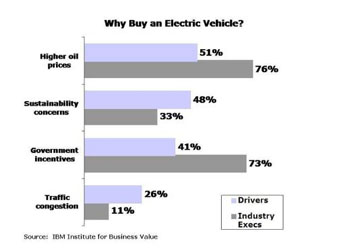Bumpy Roads Ahead for Electric Cars
While the automakers around the world are going gaga after introducing their new electric vehicles (EVs), analysts are taking the transition from traditional cars to EVs with bated enthusiasm.
Today, automobile vendors believe that sales of traditional vehicles will peak before 2020 and are looking to EVs as one of the next hot products. However, they will first have to address stringent consumer requirements about EV performance, recharging, and convenience.
This is revealed by tech company IBM with its new survey of consumer attitudes and a recent study of auto industry executives.
[ Also Read: Portuguese Prime Minister to Use Electric Car ]Taken together, the two studies uncover significant differences between the automobile industry executives IBM spoke to and consumers on the factors motivating consumers to purchase EVs, with auto execs placing greater emphasis than consumers on government incentives and oil prices.
The executives were also skeptical of consumers’ willingness to pay a premium for green vehicles.
[ Also Read: Mercedes-Benz Delivers Zero-Emission Vehicle ]The insights, from IBM’s Institute for Business Value (IBV), are derived from a new survey of 1,716 U.S. drivers and interviews with 123 auto industry executives. The study indicates that, even in these early days, there is a potentially large market for EVs.
Nineteen percent of drivers surveyed said that they were either “very likely” or “likely” to consider purchasing an electric-only vehicle when shopping for a new car. This is notable, given that 42 percent of drivers know only “a little” about EVs or have “only heard of them,” suggesting that automakers could increase the pool of potential buyers with sustained educational campaigns.
[ Also Read: Nissan All-Electric LEAF Comes on Road ]Thirty percent of drivers surveyed said that they would consider switching to an EV that got 100 miles or less per charge. Current EVs get about 50 to 100 miles per charge.
And 40 percent of drivers said they would pay up to 20 percent more for an electric-only vehicle compared with a similarly-featured gas-, diesel, or hybrid-powered vehicle, with 27 percent saying they would pay 10 percent more and 13 percent saying they would pay 20 percent more.
To drive the price of electric vehicles into this more affordable zone, the IBV research indicates that automakers should initially focus on sales to both consumers and commercial fleets, building scale and creating economic efficiencies in production.
[ Also Read: Electric Cars to Pick Up Speed with New Tie-up ]Automakers may also need to develop new business models for electric vehicles to overcome the higher initial price.
Nevertheless, the IBM study says, price of the home charging installation often required to support an EV could pose an obstacle to EV adoption. Only 13 percent of drivers said they would consider spending more than $1,000 to retrofit their residence to support recharging of an electric vehicle.
According to industry estimates, retrofitting to a 240 volt outlet accessible to vehicles averages between $1,000 and $2,000.
[ Also Read: Chevrolet Volt Named 2011 Green Car of the Year ]In addition, two-thirds of consumers expect a price discount on their electricity for charging at home overnight. This expectation could place increasing focus on utilities for time-based pricing to encourage home charging, or more public charging will be required if an electricity discount is not available.
Home charging is considered important to the success of EVs. Of the drivers surveyed, 83 percent said they park their primary vehicle in the driveway or garage of their private residence, as opposed to in a parking lot, on the street, in a shared garage or some other location.
[ Also Read: IBM Software Drives Chevrolet Volt ]“Even under optimal circumstances, fully recharging an electric-only vehicle takes hours,” said Kal Gyimesi, IBV automotive lead and co-author of the IBV study.
“So, it is crucially important that we build an infrastructure that can charge vehicles where their owners park them for extended periods of time – whether that is at home or at work, school, or the store.”
Perhaps a reflection of America’s consumer culture, 62 percent of drivers surveyed said they most often parked in a mall or store parking lot when not at home or work. That’s substantially higher than any other location – “on the street” was number two at 17 percent.
[ Also Read: Hyundai Launches Blue Link Telematics Platform ]“When deciding where to put charging stations, retail hubs like malls and shopping centers are good locations,” Gyimesi said.
“It’s easy to envision charging stations in these commercial locations coupled with an advertising and promotion-based business model for local stores – which will help make the economics more feasible.”
The automobile industry executives IBM interviewed for this study place far greater weight than consumers on government incentives/regulations (73 percent to 41 percent) and significantly higher oil prices (76 percent to 51 percent).
The executives also place less emphasis than consumers on green image/sustainability concerns (33 percent to 48 percent).
Advertisements:
Business Proposal
Digital Media Campaigns
Raman Media Network: Connecting Communities
According to the IBV study, when asked executives how automakers could develop mobility solutions, 83 percent said that the best direction would be to shift their product portfolio from conventional vehicles to electrified vehicles (EVs). About half said they expect the annual sales of conventional vehicles to have begun to decline by 2020.
Responses for the driver survey were similar across urban, suburban and rural areas — with some notable exceptions. For example, rural respondents were the most likely (59 percent) to say they would pay nothing more for an electric-only vehicle compared with a similarly-featured gas-, diesel, or hybrid-powered vehicle.
IBM released the study findings Tuesday, Jan. 11.




